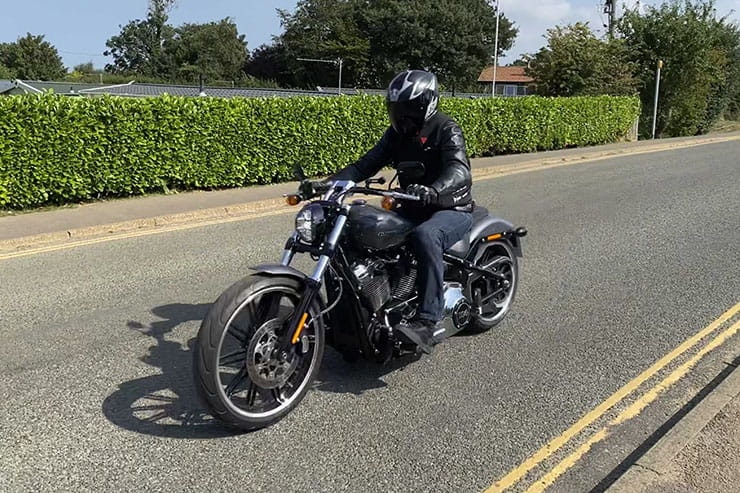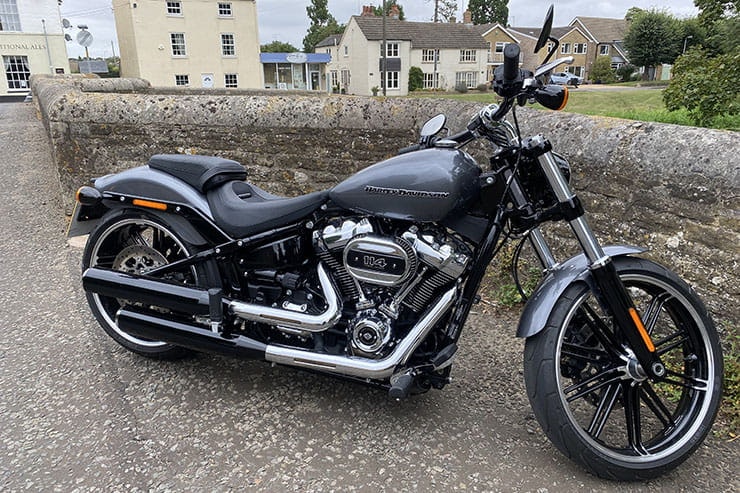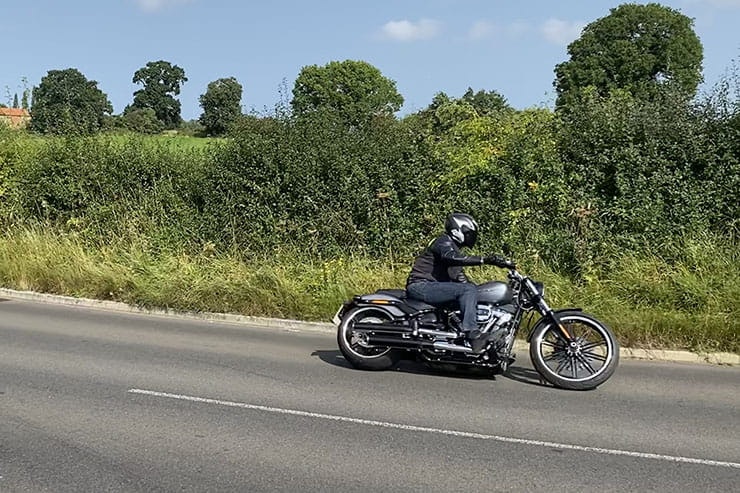Harley-Davidson Breakout 114 (2021) - Review
By Michael Mann
BikeSocial Managing Editor
23.09.2021
Kit Credits
Helmet
AGV K-5 Jet, £229.99 | www.agv.co.uk
Jackets
Dainese Settantadue Chiodo, £128.98 | www.dainese.com
Dainese Smart Jacket (airbag), £649.95 | www.dainese.com
Trousers
Dainese Denim Regular Tex Pants, £159.95 | www.dainese.com
Gloves
Dainese X-Strike, £89.97 | www.dainese.com
Boots
Dainese Street Darker Gore-Tex, £229.95 | www.dainese.com
The big Milwaukee-Eight 114 twin-cylinder motor was strapped into the Softail range in time for the 2018 model year, including the mighty Breakout. That extra capacity led to faster acceleration and faster roll-on… not necessarily what Harley-Davidson owners had at the top of the requirement but handy nonetheless. The Breakout too came with a new fuel-tank, greater lean-angles to fit alongside that mightier 240-section rear tyre and its already statuesque appearance. Feat forwards, swept-back bars, long over-and-under silencers at mismatched lengths plus that dragster-style look with a raked out and massive 21” front wheel, mean it’s an imposing motorcycle. To look at, sit on or listen to. It’s not shy and neither should its riders be because you need some level of strength to manoeuvre and manhandle this biggy, particularly with low-speed control.
This more traditional hardcore bagger is more pure Harley-Davidson than the more modern Livewire and Revolution Max-powered Pan America and Sportster S.
Road presence & striking looks
Thundering performance & noise
Seat comfort
Far too expensive
Needs an extra front brake disc
No creature comforts or rider aids
Harley-Davidson Breakout 114 (2021) Price
How much is the Harley-Davidson Breakout 114? £19,995
That’s for the Vivid Black option, one of four available. Opt for Gauntlet Gray Metallic or Midnight Crimson and you need to add £350 to the price whereas Snake Venom is another £1140 on top. Compared to a Ducati XDiavel or Triumph Rocket 3 and the array of rider aids, safety electronics and even twin discs and a decent TFT screen and the Harley investment looks week. But just hear that engine thumping away and think of the simplicity of the ride. It’s horses for course and some riders will enjoy that minimalism.
If you’d rather go down the monthly payment route, then lay down a £5k deposit on the Vivid Black bike with an annual mileage of 4,000 over a 3-year term and you can expect to be paying less than £180 per month on the PCP deal.
Power and Torque
Press and hold the ignition switch for a second and, after a couple of rotations, the big 1.8 litre twin shakes itself into life with real emphasis. That sensation is good enough to make plenty of troubles disappear. Grab the hunking great clutch lever and, making sure you’ve had your Weetabix that morning, haul it in and give the gear lever a concerted shove to engage first. You’ll know it’s in because of the clunk you’ll inevitably hear and feel. It’s quite rewarding actually. Note the flex in the clutch cable when you begin to release, it’s like a Rottweiler straining at the leash at the sight of the postman. There’s plenty of torque here waiting to be discharged, it’s neither Rocket 3 nor even Fat Boy level but it’s still feisty.
Peak torque, according to Harley-Davidson is 115Nm (84.8lbft) @ 3250rpm while peak power is 94hp (69kW) @ 5020rpm, and that’s only just below the red line of 5600rpm.
Engine, gearbox and exhaust
The sun to our solar system, the James Cordon to The Late, Late Show, the Emma Raducanu to British Tennis, the Milwaukee-Eight 114 V-twin is the centre of what makes this Breakout a Harley-Davidson. It’s like the engineering department wedged the motor into a frame, stuck some bars and wheels on then went home for tea. And patted themselves on the back too. As well they might because this powerplant validates what an all-American approach to laid-back cruising is about. It is what Harley-Davidson’s should emanate, it’s full of soul, noise, vibrations and mechanical parts clanging, banging, spinning and pumping. I remain impartial to the Harley-Davidson clichés though I’ve certainly been surprised by the recent EV and Revolution max era but then again, the brand got to a sink or swim situation and had to diversify. Thankfully, the heart remained, and this V-twin continues to offer joy to its fans and with just the right amount of feeling courtesy of the balancer shafts cancelling out too many vibes.
Fire it up and it wants to converse. The heavy clutch lever has a late bite but tickle the revs and the sheer quantity of torque will have you off and away with little throttle roll. Yes, there’s a rev counter. A digital one that might as well not be there; a) it’s tricky to see, b) it’s a bit hit-and-miss in terms of accuracy, and c) you don’t need it because you can’t fail to hear the soundtrack. It’ll soon peter out at 5,600rpm but unless you’re on the run there’s no need to be up there. Haul that clutch lever in and be positive and strong with the gear lever and the fun begins again. Plod along at 2-3k rpm in 4th and everything’s quite serene but roll on the never-ending and rather thick throttle grip and the Breakout breaks free, propelling yet more growls from those silencers. The engine has been fettled to conform with Euro 5 regulations and while it ticks over with few revs, the engine spins up quickly and with a little electronic whine mixed in at the start of its call, the noise quickly becomes a much deeper, intermittent, semi-soft bark.
Those pipes are low to the ground too which reverberates the sound nicely, and you’d be into that kind of thing if you owned a Harley of course, but they’d never scrape the ground because the hero-blobs on the foot pegs protects them well with a 27-degree lean angle permitted each side. The shiny chrome and black on the exhaust run offer a neat and stylish finish too.
Handling, suspension and weight
The 21” front wheel is, by ratio, very narrow and despite the combined weight of bike plus rider, there’s still a tendency for that front wheel to track some of the deeper groves in the road, particularly around the Fen roads of north Cambridgeshire where heavy articulated lorries smash up the tarmac. It’s not a common pairing – 21” 130/60 front wheel with an 18” 240/40 rear – so much so that cornering becomes a specialist art. Add in the maximum 27-degree lean angles and that 305kg (plus my own 89kg on top) and faster, longer curves are comfortable enough but it’s the tighter turns that require far more dexterity, strength and patience.
Show it the corner before barrelling in too quickly otherwise an embarrassing Breakout-shaped hole in a hedge will be how the emergency services can find you. Once you’re familiar with its awkward tendencies, there’s plenty of entertainment to be found. Just don’t go chasing sportsbikes.
For a raked-out cruiser, there’s a decent spread of suspension travel – 130mm to be precise – and that’s enough to contain most of the nasties, though the rear monoshock’s 86mm doesn’t follow-up with as much comfort. So, if you catch a crevice or pothole in your eyeline too late to dodge it, then while the front wheel soaks it up it’ll be the rear that jolts your spine. That said, the preload of that monoshock is adjustable but a knob located under the seat and can be adjusted on the fly.
When you do park up, just be extra careful with the straw-like side stand. It has a mind of its own.
Comfort and economy
Breaking news: I have found a cruiser/bobber/feet forward bike that I am comfortable on! Since the Triumph Bobber came out in 2017, I’ve struggled with finding a bike with this riding position in anyway comfortable after as little as 20 miles, it was where spine meets coccyx where I suffered. I’m 6ft tall (182cm) and 14 stone (196lbs / 89kg) and found the Breakout 114 to be the best so far. The rider part of the two stage seat is hollowed out with plenty of support around the sides while the riding position may seem less-than-comfortable from the side-on shots, my legs are bent enough (almost 90-degrees even) and the reach to the ‘bars isn’t too far either. One of the first rides during my couple of weeks with the bike was 65-miles in one hit and I even found the splayed-out leg style not too painful. Motorway speeds aren’t where this bike is pitched and the lack of weather protection is telling particularly against my chest and pushing my knees out. Then again, I was only within touching distance of the legal limit for only about five miles.
The fuel tank size was reduced when the Breakout was last upgraded as Harley-Davidson opted for style over distance. Again, that’s how this bike is positioned, it’s not a touring machine. Even so, 13.2 litres should see an easy +130-mile range.
Harley-Davidson Breakout 114 Brakes
While cruising and posing is its forte, stopping isn’t. The big heavy front brake lever isn’t as easy to grab and hold in an emergency as I’d like. And trust me, I know courtesy of a U-turning and non-indicating Zafira driver. A double disc at the front should be standard on a bike weighing north of 300kg with a peak torque figure of 115Nm.
The rear brake lever is a little spongey, but I liked that because it allowed me to settle the bike on corner entry, and even trailing through it. I also preferred not to pitch more weight onto the narrow front 21” wheel either.
Rider aids, extra equipment and accessories
The Breakout 114 is rather sparse in the creature comforts department. To some this may be a blessing considering the array of options and buttons with some of the modern-day hi-tech motorcycles, i.e. Africa Twin or Multistrada V4. Simplicity is the key, and with four x two-way rocker buttons plus the odd individual indicator buttons (one on each side of the handlebar layout), there are no rider modes, heated grips, suspension settings or TFT screens to distract from the ride. For a £20k bike, I’m disappointed with the tiny digital screen. I mean it gets points for being tucked away nicely by being embedded neatly into the handlebars, but the sun’s glare provides an issue with the concave glass and it requires more than a fleeting glance to find then read what you need to know.
The indicators are self-cancelling, a supplement which has become increasingly common over the past decade. At first, I thought it was trying to fix a problem that didn’t exist but on reflection, even if you rely on them once and once only to save you from an incident then they become worth their weight in gold. My issue is the inconsistency; they’ve either cancelled themselves before I’ve made the turn, or the benefit of not having to remember to switch them off is eradicated because I still have to visually check. Nevertheless, to confuse the issue further, Harley-Davidson put the right-turn signal on the right bar adjacent to the throttle, which is massively inconvenient, while the left-turn indicator in is in the conventional place. Indicating to turn right means releasing the throttle unless you’ve got strong fingers and a long thumb. Then the ‘click’ of reassurance with the action of the button isn’t as guaranteed as I’d want.
Keyless ignition and a USB port is about as modern as it gets. The round fob can be conveniently tucked away inside your jacket and while a key dangles from the same fob, its only job is to operate the steering lock which means the fuel tank isn’t lockable. The USB port is hidden behind a rubber cover on the left-side of the frame behind the forks.
Rivals
Among the battle for the best buxom bruiser are these four heavyweights up to whom the Breakout matches up in terms of riding position and road presence. In this category, introverts need not apply, nor those with minimal experience at handling big-but-low cruisers. A quick scan over the table will demonstrate a fairly good match-up in price, once the BMW has a few almost mandatory options added. Torque figures are so vast they’re almost incomparable despite the huge difference between the 127Nm of the Ducati vs. the Triumph’s enormous 221Nm. On the road they’d all be very strong off the line and unless you regularly frequent drag strips on your cruiser, the gap between them is much more subtle than the spec sheet suggests. When comparing power, it’s best to also consider weight but then again, you’re looking at the wrong bike type if power is a deciding factor.
Harley-Davidson Breakout 114 (2021) Verdict
For what the Breakout 114 lacks in creature comforts, it makes up for in presence and power. With the rumbling, rattling V-Twin chugging away and enough polished chrome to blind the Sun, it’s pedestrians and other road users who are quick to notice the Harley. Whether its admiring glances, raised eyebrows or tuts, the Breakout will attract attention of all kinds. Shuffling around at low speed with all that weight and width plus an extreme tyre size difference can be a little ungainly so if you have a gravel driveway or live on a narrow or sloped street then think twice before committing to your 20-grand outlay.
For its honest, up-front, minimal distraction, commanding salt o’the earth macho attitude, the Breakout will continue to be popular in the Harley line-up, though once the current flock of customers move on or retire from riding then where is the next batch coming from? There’s a lot of expectation when you’re spending that kind of money on a motorcycle, particularly one with H-D brand allure, and this big, brash, bold, highly-polished feet-forward cruiser will soon be out-pricing itself.
And then there’s the customising options. Take it to a builder or do it yourself but the official and unofficial options are plentiful to make your mark with this expensive template.
Harley-Davidson Breakout 114 (2021) Technical Specification
Photos: Peter Burgess / Michael Mann
What is MCIA Secured?
MCIA Secured gives bike buyers the chance to see just how much work a manufacturer has put into making their new investment as resistant to theft as possible.
As we all know, the more security you use, the less chance there is of your bike being stolen. In fact, based on research by Bennetts, using a disc lock makes your machine three times less likely to be stolen, while heavy duty kit can make it less likely to be stolen than a car. For reviews of the best security products, click here.
MCIA Secured gives motorcycles a rating out of five stars, based on the following being fitted to a new bike as standard:
A steering lock that meets the UNECE 62 standard
An ignition immobiliser system
A vehicle marking system
An alarm system
A vehicle tracking system with subscription
The higher the star rating, the better the security, so always ask your dealer what rating your bike has, and compare it to other machines on your shortlist.


